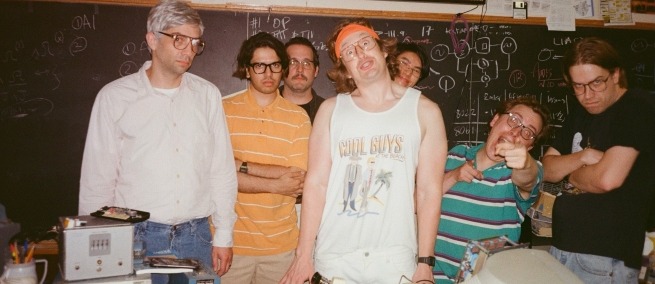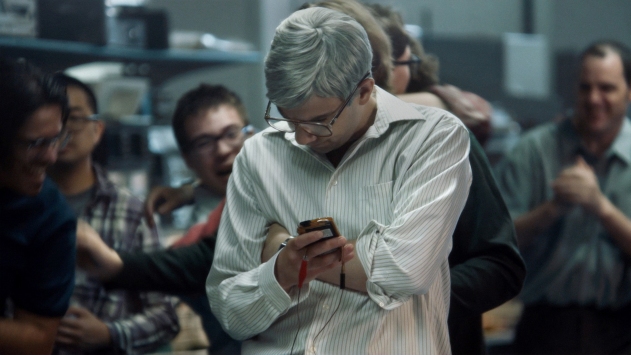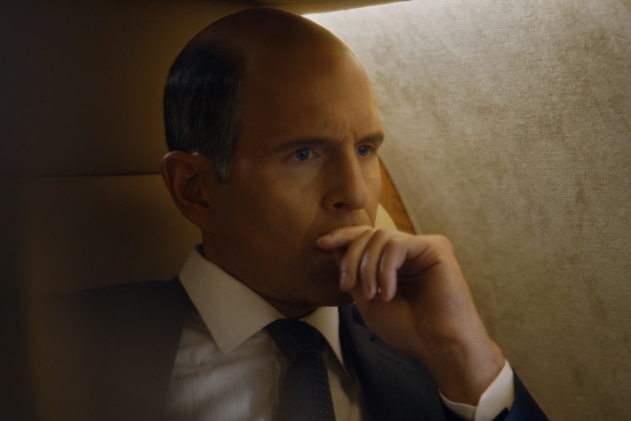
Matt Johnson’s BLACKBERRY, which made its world premiere at the 2023 Berlinale and won the Sloan Science on Screen Prize at SFFILM in April, tells the story of the first smartphone. It follows engineers and founders of the start-up Research in Motion Mike Lazaridis (Jay Baruchel) and Douglas Fregin (Matt Johnson) and the explosion of their product as they begin to work with businessman Jim Balsillie (Glenn Howerton). BLACKBERRY was released by IFC Films and is available to stream on VOD. We spoke with writer/director/actor Matt Johnson about his research for the film, its production design, and the appeal of the story.
Science & Film: What was your relationship to the BlackBerry before making this film?
Matt Johnson: I was in some ways lucky because when I started making this movie, I had only known of it as the type of phone my dad had when I was a kid. And I knew about it as a historical Canadian story. But I had no personal relationship with it whatsoever. I didn't have a BlackBerry and I never even touched one before I got to set. And I'm happy that it was that way because—and I think about this a lot when I'm making films, and I think other filmmakers have said something similar—the concept of having a real beginner's mindset with the content you're making a movie about is more valuable than people would think. Like the fact that I did not know anything about what this machine did, or how it worked specifically meant that I was able to learn all of this stuff from a total neophyte's point of view, and in learning about it, figure out how best to explain that to an audience. If you come at the subject from a position of expertise, you are a few too many levels above a general audience. I'm like a little explorer going to a place that nobody's been and I'm like oh, look what I saw, I saw this and I saw this and I'm blown away. Whereas, you know, when you've been talking to somebody who has lived there for 50 years, they'd be like, yeah, whatever, we see that every day. They're almost inured or cynical about their surroundings. Whereas for me, it's brand new. Like, look at this bird! I just think everything is so cool.
S&F: That makes sense. In terms of your process for learning, how did you go about trying to understand what was important about the BlackBerry?
MJ: I always do it through interviews. I was fortunate that my dad had a best friend, from a county in Ontario called Thunder Bay, who had started a telecom company in the 90s. His name is John Lyon and he had started a cellular company and it was just by pure luck in the exact era that BlackBerry exploded and became a major national and then international product. And so, he was able to explain as a family friend of mine how the cell system worked and what BlackBerry was doing that other phones had never done up to this point from an on-the-ground perspective.

Still from BLACKBERRY, courtesy of IFC Films
I also spoke with so many ex-employees who tried to explain the technical side of it. But I was slightly too dense to really get the design elements of what the phone is—like what parts of a computer they used, and how it was actually constructed. But at the same time, I was like, this is too complicated for me, or it's too boring, so maybe people aren't going to care about this. Two big things I wanted to get across, from a technical point of view, that I found extremely interesting about the saga of what the BlackBerry was, one: that they reinvented how devices would access the internet through pull data service, which is to say, as Mike explains in the first act of the film, the idea that rather than having a device that is constantly checking on a server, instead the server could push information to the device. That was a massive breakthrough, push email, which is still basically used today on all devices. And the other [thing I wanted to get across] was a market innovation, which is that rather than using smartphones as a business tool, they would instead completely move the market to data sales. Rather than selling minutes, and selling airwave space, they would be selling data. I hadn’t realized what a massive shift that was until I started researching this phone.
S&F: Yeah, that reminds me of the line in the film: the problem is there's only a minute in a minute.
MJ: Yes, which is quite a brilliant observation by the head of AT&T Stan Sigman. Telecom then, it’s not the world we live in today. Verizon to me is such a perfect example because it began as a much smaller company. Bell famously was split apart—Bell Atlantic, BellSouth—so that they wouldn't have a stranglehold on the market. So, Bell Atlantic, the New York division of Bell, is not a huge company. And their business model is basically trying to convince consumers to use their cellular products, and they sell the minutes. And so the CEO of that company is not a technological genius, he's kind of a relationships guy, he's like one of these old school 80s, 90s CEOs who loves other people and people like. And then all of a sudden, this data revolution happens, and he finds himself not out of step with where things are but he's not a great technical innovator, and so you get these kinds of folksy sayings like, there's only one minute in a minute. Like these are the types of things that you would just never hear coming out of the mouths of Tim Cook, or modern tech CEOs. It's such a great collision of the way business was done in 70s and 80s and this new web 2.1 innovation or die––and I really love the era. It's so folksy, and almost stupid and yet, it was absolutely the problem that they had basically capped how much they could sell to an individual user, because they were limited by the time period. You can't sell more than one minute to somebody.
S&F: Did you talk to anyone who is represented in the film for research?
MJ: We didn't know whether or not they were going to have a positive or negative reaction to the fact that we were even making this movie, so we were making the film in complete secrecy. We had code names. We didn't want the city of Waterloo to know we were making a movie. We were trying to operate in such a clandestine way, because we were shooting at the real places that these guys did this stuff and we didn't want to get caught and shut down or rejected.

Still from BLACKBERRY, courtesy of IFC Films
It was really important to me to use as many of the real locations as we possibly could. So, all the exteriors are real. Even small examples, like the big hockey arena that in the film is set up for a basketball game and it's called Copps Coliseum, which is the big stadium that Jim Balsillie attempted to buy in order to move that hockey team—we used that real place. Canada is still a pretty small town and Jim Balsillie is very powerful. If he was like, I don't want anybody working with these guys, that would probably have halted a lot of the ideas we had. But now that the film's been released, they're all happy. I wish I had Jim's help when we were making the movie! [laughs] But I did speak with a lot of engineers who were early employees—like employee number 20, employee number 22, people who you do see represented in the film, but they aren't really featured.
S&F: How did you learn about the office culture of BlackBerry, things like movie nights that you show in the film?
MJ: That I got exclusively from an ex-employee, one guy in particular, named Matthias Wandel, who I based a lot of my characterizations on. Like Doug [Fregin] is tricky, he's never really been interviewed. There's no video footage of that. If you want to hear more from Wandel, he recorded a commentary track on the DVD/Blu Ray, you can hear his thoughts on the movie and all the things we completely screwed up. He was in some ways the basis of my character.
S&F: In terms of the production design—the wardrobe and old computers—how did you source those? What were you basing those depictions on?
MJ: It was one of the bigger challenges going in because it’s a fairly small budget movie, certainly by American standards, and I knew that I wanted the characters to authentically use all of these PCs, and I wanted them to all be era PCs. So we started sourcing material very early on. Adam Belanger who was the production designer, he and Kerry Noonan who was the Art Director, are such sticklers. They decided they were going to do everything real, and so it was them buying collections from people online, it was going to different parts of Ontario and buying old PCs that were in repair shops, picking up all of that stuff, and then finding a way to get them running the type of software that these guys actually used. All the PCs you see are real, all the BlackBerrys you see are working. We bought a huge collection early on—500 or 600 different era BlackBerrys from the late 90s to the 2007 era. The only thing we couldn’t do, as much as we tried, was to get a local network with the BlackBerrys all speaking to one another; that proved to be impossible. The BlackBerry servers were turned off right before we started shooting the movie, which is such bad luck.
Matthias Wandel, again he deserves so much credit, gave us his photo diary that he took between 1996 and 2006, where he was a very dedicated photojournalist while working at Research in Motion, and he took a bevy of photographs of things that he found interesting. That included all their warehouses, all their manufacturing facilities, all the clothes that they wore, products, prototypes… Thousands of photographs that he gave us in a diary, and we use that as our bible for recreating everything. So, if we if we couldn't find something and actually buy it, we just rebuilt it—Belanger and Kerry just rebuilt it using whatever they had. We would not have been able to do it were it not for that diary of photographs that nobody's ever seen before. Because again, it's funny, after 2005/2006, the company really did become international, like everybody was interested because the stock price was so high and everyone woke up to what a big deal it was. There are all kinds of documented images and stories of the company post-2006/2007. But before then, especially in the 90s, it was almost impossible to find images because it was just like any other startup: why would this company see themselves as special? It’s not like the news was breaking down their door to share what was going on. If it weren’t for this guy [Matthias Wandel] we would have no idea what these places looked like.
S&F: I wonder what you think this story means to people now?
MJ: I'm always trying to make movies about my own life, and it's only afterwards I realize whether they have any relevance. There are other tech origin movies, and what I think is happening is that people are almost lost and confused in the sea of technology that we find ourselves in and are trying to find answers as to how we got here. And I think it's why these based on the true product-style films are becoming so ubiquitous right now, and why there seems to be so much interest in them. Like how there was an explosion of war movies after World War II because that was the most important cultural thing that had occurred for people, and it needed to get picked apart and analyzed just so we could understand what it was. Right now, we're living in a brand-new world of instantaneous technology. So, I think this wave of movies is trying to explain what that means. BlackBerry specifically, I don't know. I know that I love those characters and that it in some ways seems to show what happens to friendships when you combine the kind of fraternity and idealism of youth with astounding success and huge egos, but what that means vis-à-vis all these other stories is not for me to say but for other people to try to figure out. I have no idea.
♦
FILMMAKERS
PARTNERS
TOPICS